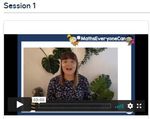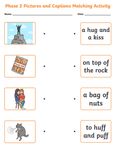MARLBOROUGH PRIMARY SCHOOL RECEPTION HOME LEARNING
←
→
Page content transcription
If your browser does not render page correctly, please read the page content below
MARLBOROUGH PRIMARY SCHOOL
RECEPTION HOME LEARNING
WB 25th JANUARY 2021
Date: Monday 25th January 2021
Reception Daily Plan
Dear Parents and children,
Attached to this daily plan and we have made a timetable for you to follow.
Monday, Tuesday, Wednesday and Thursday via Microsoft teams there will be an opportunity to log on and
be involved in a class session. This will happen at 2:30pm.
We can also provide paper copies of all work should you prefer to complete the learning this way. These will
be available for collection from 9am each morning.
If you have any questions, please don’t hesitate to contact us via Microsoft Teams, Tapestry or via the
school office email.
Take care,
Reception Team
Phonics- This week’s sounds are: k, ck, e, u, r
There are now online phonics lessons that you can watch with your child. These
lessons will provide revision and consolidation of the objectives we have covered in
school.
Learn to read words
High frequency words:
on, up, back, if, but, of,
into
Please click on videos then choose Reception Lesson 14 (Part 1) for today’s lesson.
https://www.youtube.com/watch?v=a_LqbZKkdlE&list=PLuGr6z2H2KNGLy2Tckcy8Kk
8u10mXgcmi&index=70
Use the login details for Phonics play;
Username: jan21
Password: home
Go onto Resources- Phase 2 to access games for Reception.
Play the game Buried Treasure to practise reading words. Select Phase 2.
What are frequency words?
High frequency words are those which appear most often in the language - many are also common exception words (e.g.
‘I’, ‘the’, ‘you’). Children are taught to learn these words by sight in order to increase the Fluency of their reading.
Reading
Ask your child to read each word or caption and match to each picture.
They may want to use their robot arms to help them.
Encourage your child to segment (sound out) and blend the sounds together. Ask your child to read each word
independently before supporting them.
All children ChallengeExtension- Read a book using bug club.
Learning objectives:
- Hears and says the initial sound in words.
- Can segment the sounds in simple words and blend them together and knows which letters represent some of them.
- Begins to read words and simple sentences.
- Enjoys an increasing range of books.
Free audio books: https://stories.audible.com/discovery
Note to Parents
Which phonemes does your child recognise and find on a phoneme mat? Which High frequency and tricky words can your
child read independently? Is your child able to track the text while reading?
Does your child recognise individual phonemes?
Are they able to blend the sounds together to read each word?
Do they recognise the difference between fiction and non-fiction books?
Today’s writing activity
Read our new story of the week- Emma Jane’s aeroplane.
Look at the front cover. What do you think the story is
about?
Story focus- Emma Jane’s Aeroplane
QFL: Can you write a list?
Learning Objectives
- Uses some clearly identifiable letters to communicate
meaning, representing some sounds correctly and in
sequence.
- Writes own name and other things such as labels,
captions.
- Attempts to write short sentences in meaningful Answer the following questions verbally as you go through
contexts. the story.
- To read and understand simple sentences. - Which places did Emma Jane visit in her aeroplane?
- To use phonic knowledge to decode regular words and - Which animals did she meet in the story?
read them aloud accurately and read some common - What did the fox dislike?
irregular words. - What did the dragon do in the story?
- Can you find 2 rhyming words in the story?
e.g Jane/aeroplane
Where do you think she will fly next?
ActivityWrite a list of the places Emma Jane visited.
Challenge: Which of these places do you want to visit and
why? E.g I would like to go to _______
Because__________________________.
Note to Parents
Can your child:
Think of a sentence and say it out loud?
Count each word on their fingers. Use spaces between fingers as finger spaces. Hear sounds in words independently?
Find each phoneme on a phoneme mat?
Correctly hold their pencil and write each letter?
Today’s Maths activity
Starter:
Introduce child to repeating pattern by watching this video and interacting with the
questions posed.
https://www.youtube.com/watch?v=aF5XXQFMDSo
QFL: How can I create a
repeating pattern?
Success criteria:
I can use two objects to create
a repeating pattern For main teaching please watch the video on this site:
https://whiterosemaths.com/homelearning/early-years/week-3/
I can describe a pattern
I can identify common shapes in
my pattern
Gather some natural objects from your garden or a walk.
Chose two different objects and make a repeating pattern with them
ExampleDescribe your pattern to an adult. What can you notice? What colours have you used?
What sizes are the objects?
As a challenge See how many different patterns you can make.
Note for parents: Go on a pattern hunt around the house and find some more patterns. What did you find? How many
more can you find? Can you spot patterns outside your window?
Topic- Let’s go on adventure
QFL: To understand and know what Burns Night is.
What is burns night?
Burns Night is a celebrate often held in Scotland around 25th January.
It celebrates the life and work of a famous writer named Robert Burns.
Robert Burns was born on 25th January 1759.
He was a poet and song writer and is famous around the word.
Learning objectives One of his most famous songs is Auld Lang Syne, which is often sung at New years and
Burns night.
- Choose particular colours to On Burns night, many people have a traditional dinner called Burns supper.
use for a purpose. This is usually including eating haggis which is a traditional Scottish food.
- Explore what happens when It is often served with neeps (swede) and tatties (potatoes). Before people start
they mix colours. eating their Burns Supper, the Selkirk Grace is often said
- Understand that different
media can be combined to create Watch this Video:
new effects. https://www.bbc.co.uk/newsround/16722720
- Manipulate materials to achieve
a planned effect. Bagpipes are often played during Burns Night celebrations.
Bagpipes are instruments that are played by blowing into reeds and squeezing a bag of
air.
- Begin to build a repertoire of
Have you heard bagpipes before?
songs
https://www.youtube.com/watch?v=xqeYKf8tdsU
- Select tools and techniques
There is also lots of traditional Scottish dancing. Many people wear clothes made of
needed to shape, assemble and
tartan fabric, including kilts.
join materials they are using.
Activity:
Complete a simple program on a
computer. Design your own Tartan Kilt.
• Use ICT hardware to interact To celebrate Burns night draw, design or create your own kilt.
with age-appropriate computer You can use junk modelling, paper, or fabrics.
software.
Extension:
Can you answer these questions?
Remember to use full sentences.1. Where do they celebrate Burns night?
2. Who was born on the 25th of January?
3. What was he famous for?
4. What did they eat as their special meal?
Fine Motor Monday- Choose one of these activities to complete.
Physical Development: Moving and Handling- Make a number weave
You will need:
Cardboard/card
Coloured paper
String/ribbon
Pen
Rescue the animals
You will need:
Box
String
Tweezers/tongs
Small objects/objects
Microsoft teams activity- 2:30pm everyday
Log into your Microsoft teams account- an email will be sent with a link for the scheduled meeting.
Monday, Tuesday, Wednesday and Thursday this will happen at 2:30pm.
The short activity will involve story time, singing nursery rhymes or completing an activity altogether as a class.
Useful websites-
https://www.thenational.academy/online-classroom/reception#subjects – This website has been set up by the
Government and provides some online learning for children
https://www.picture-news.co.uk/ - more resources for your child to access.
https://whiterosemaths.com/resources/schemes-of-learning/reception-sol/ - Maths resources.
https://www.topmarks.co.uk/ - Useful maths games for all ages
https://www.twinkl.co.uk/- Twinkl now has a free subscription and free resources.
https://www.ictgames.com - Maths and Literacy online games
We recommend reading good quality books together at home and playing lots of board games.You can also read

























































